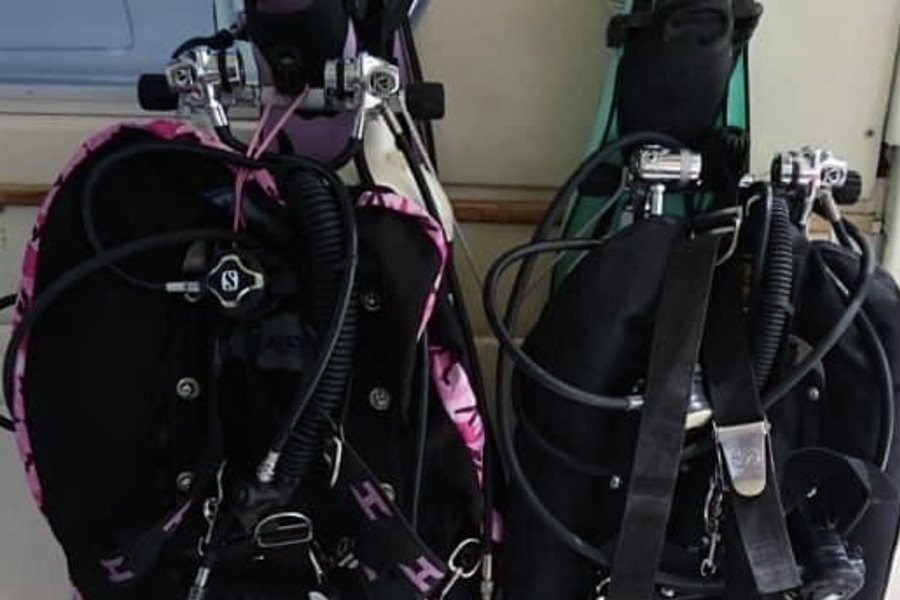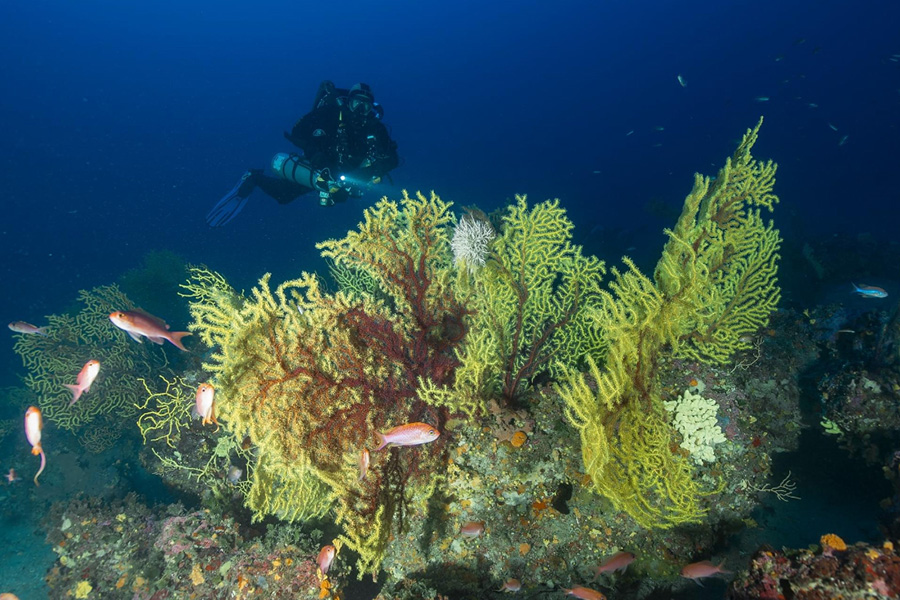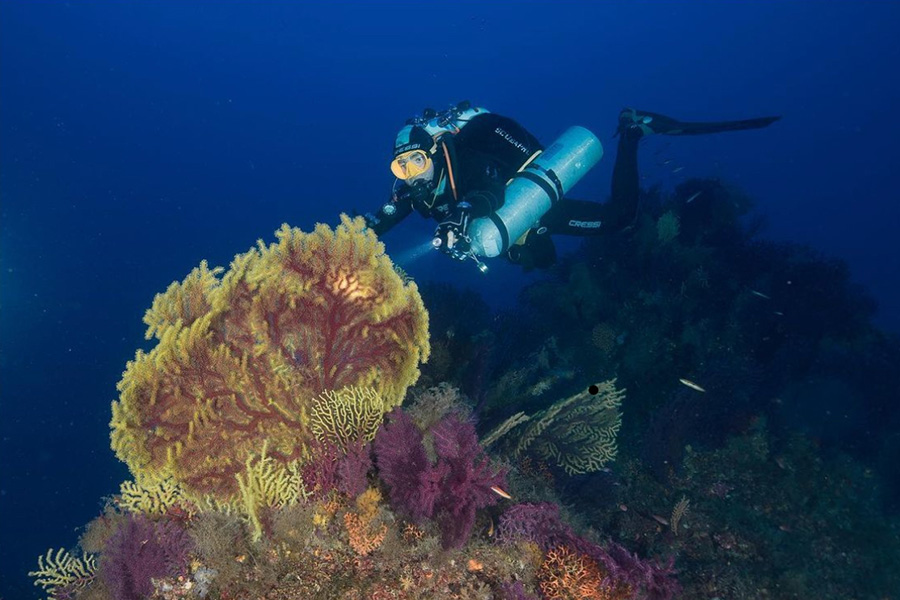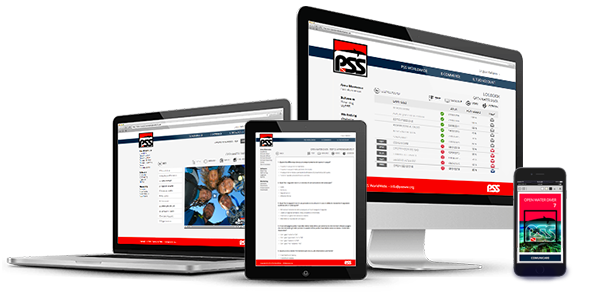PSS technical courses
Technical diving is diving carried out for personal pleasure but which goes beyond the safety limits of so-called recreational diving.
They make it possible to descend to much greater depths, extending the time spent on the bottom and increasing the time of the dive in general, with specific skills in the use of equipment, breathing in gas mixtures different from the air we are normally used to breathing.
For this reason the PSS technical courses are the logical progression for those divers who, with adequate training and proven experience in recreational diving, wish to dive and discover the underwater world beyond the limits of no decompression.
They represent a turning point in diving, a long and demanding path to certification, but also a phenomenal opportunity to discover the underwater world in even greater detail.
Obviously, technical diving also has its limits, which must be respected, especially when teaching.
These limits are listed below so that all divers can be aware of them.
Maximum Depth Limit:
We know that the maximum depth limit for recreational diving is 40 metres, and that if you go beyond this limit you will be considered a technical diver. In technical diving it depends directly on the breathing mixture used.
During PSS training, the following absolute depth limits may not be exceeded:
– Diving with air or nitrox max 50 metres (165 feet)
– Trimix dives max 100 meters (330 feet).
Partial pressure of oxygen – At all times during the dive, the partial pressure of oxygen in the breathing mixture must be between 0.14 and 1.6 bar. The maximum programmed partial pressure of oxygen for the purpose of calculating the optimum bottom mix shall not exceed 1.4 bar.
Partial pressure of nitrogen – At no time during the dive may the partial pressure of nitrogen exceed 4.75 bar. The recommended partial pressure of nitrogen as an upper limit is 4.0 bar.
Decompression time – In technical diving, the limits of the safety curve are usually exceeded and mandatory decompression stops must be performed. In this case, limits have been placed on the total duration of decompression (including ascent) for some courses, according to the following table:
– Decompression Techniques max 30 minutes
– Accelerated Decompression Techniques max 45 minutes

At the end of the course, the student must be able to dive without the need for professional supervision and reach a depth of 45 metres (150 feet), provided that the total duration of decompression (including ascent) does not exceed 30 minutes.
– Estimated hours of theory lessons: 10 hours (including self-study)
– Expected open water dives at least 4, with air rebreather (or nitrox with oxygen percentage between 22% and 40%, max. p.p.O2 1.4 atm)
– All dives must be conducted within a depth of 45 metres (150 feet),
– Each dive must be made with only one breathing mixture, either in the bottom tank or in the reserve tank.
– The first two dives must not exceed the limits of the safety curve and decompression must be simulated. The last two dives, at depths between 30 and 45 metres, must be planned beyond the limits of the safety curve.
– Obligation to have a medical certificate
– To access the course, the student must hold the following PSS certificates or equivalent: Deep Diver, Rescue Diver, Nitrox Diver. They must have made at least 50 logged dives, including a minimum of 20 at depths between 30 and 40 metres.
– Minimum age 18 years

At the end of the course the student should be able to dive with an air rebreather, without the need for professional supervision, to a maximum depth of 50 metres (165 feet).
The total duration of the planned decompression, including ascent, must not exceed 60 minutes (even in the case of ascent with only bottom mix) and it is foreseen to use only binary nitrogen-oxygen mixtures, with an oxygen percentage higher than 20% and a single decompression nitrox cylinder carried by the diver with a mixture can vary from 28% to 80%.
The use of pure oxygen is only envisaged in addition to the first decompression and with a cylinder left at the decompression station (or dispensed through a hookah).
– Estimated hours of theory lessons: 8 hours (including self-study)
– Expected open water dives at least 3, using a decompression mixture other than the bottom one
– All dives must be made within 45 metres (150 feet) depth
– The first dive must not exceed the limits of the safety curve and decompression must be simulated. The last two dives must be made with air or nitrox as the bottom mixture, at depths between 40 and 50 meters (130-165 feet), and must be planned beyond the limits of the safety curve; the total duration of the decompression, including ascent, must not exceed 60 minutes, even in an emergency when the decompression mixture cannot be used.
– Obligation to have a medical certificate
– To access the course, the student must hold the following PSS certificates or equivalent: Decompression Techniques, Deep Diver, Rescue Diver, First Aid-C.P.R., Oxygen In Diving Emergency, Nitrox Diver.
– Must have made at least 75 logged dives of which at least 10 with nitrox and 10 with planned decompression stops.
– Minimum age 18 years

It is essential, as the 60m Trimix course forms the basis on which the student’s future diving with ternary mixtures will be built. In addition, the basic theory necessary for the use of helium in breathing mixes is taught in this course.
At the end of the course the student should be able to dive with an aqualung, without the need for professional supervision, to a maximum depth of 60 metres.
The total duration of the planned decompression, including ascent, must not exceed 90 minutes (also in emergency), and the use of binary oxygen-nitrogen mixtures and ternary oxygen-helium-nitrogen mixtures is foreseen, with an oxygen percentage of 20% or more.
The use of a decompression mixture other than the bottom one is foreseen, in which the percentage of oxygen in this mixture can vary from 27% to 100%.
– Estimated hours of theory lessons: 12 hours (including self-study)
– Expected open water dives at least 4, using a decompression mixture other than the bottom mixture.
– All dives must be carried out within a depth of 60 metres
– On the first dive, the limits of the safety curve may not be exceeded and decompression must be simulated. On the second dive, 50 metres (165 feet) may not be exceeded. The first two dives may be made using air or nitrox as the bottom mix. The last two dives must be made with trimix as the bottom mix, at depths between 50 and 60 metres and must be planned beyond the limits of the safety curve; the total duration of decompression, including ascent, must not exceed 90 minutes, even in an emergency (impossibility of using one or both decompression mixes).
– To access the course, the student must hold the following PSS certificates or equivalent: Accelerated Decompression Techniques PSS, First Aid – C.P.R. PSS or equivalent, valid, Oxygen in Diving Emergency PSS patent or equivalent, valid.
– Having already made and logged at least 100 dives, including 25 or more with planned decompression stops.
– Minimum age 18 years

At the end of the course, the student must be able to dive with an open-circuit rebreather, without the need for professional supervision, to a maximum depth of 78 metres.
The use of binary oxygen-nitrogen mixtures and ternary oxygen-helium-nitrogen mixtures is foreseen, with a percentage of oxygen higher than 16% and the use of two decompression mixtures other than the bottom one; the percentage of oxygen in these mixtures can vary from 20% to 100%.
– Estimated hours of theory lessons: 3 hours (including self-study)
– A minimum of 4 open water dives with rebreather and with the use of two decompression mixtures other than the bottom one are planned.
– All dives must take place within a depth of 78 metres, between one hour after sunrise and one hour before sunset. No more than two dives may be made during this time (one if 60 metres is exceeded).
– On the first dive, the limits of the safety curve may not be exceeded and decompression must be simulated. The last two dives must be made with trimix as the bottom mix, at depths between 70 and 78 metres, and must be planned beyond the limits of the safety curve.
– To access the course, the student must hold the following PSS certificates or equivalent: Trimix 60 PSS, First Aid – C.P.R. PSS or equivalent, valid, Oxygen patent in Diving Emergency PSS or equivalent, valid.
– Have already made and logged at least 120 dives, including 30 and 5 or using trimix as a breathing mix.
– Minimum age 18 years

